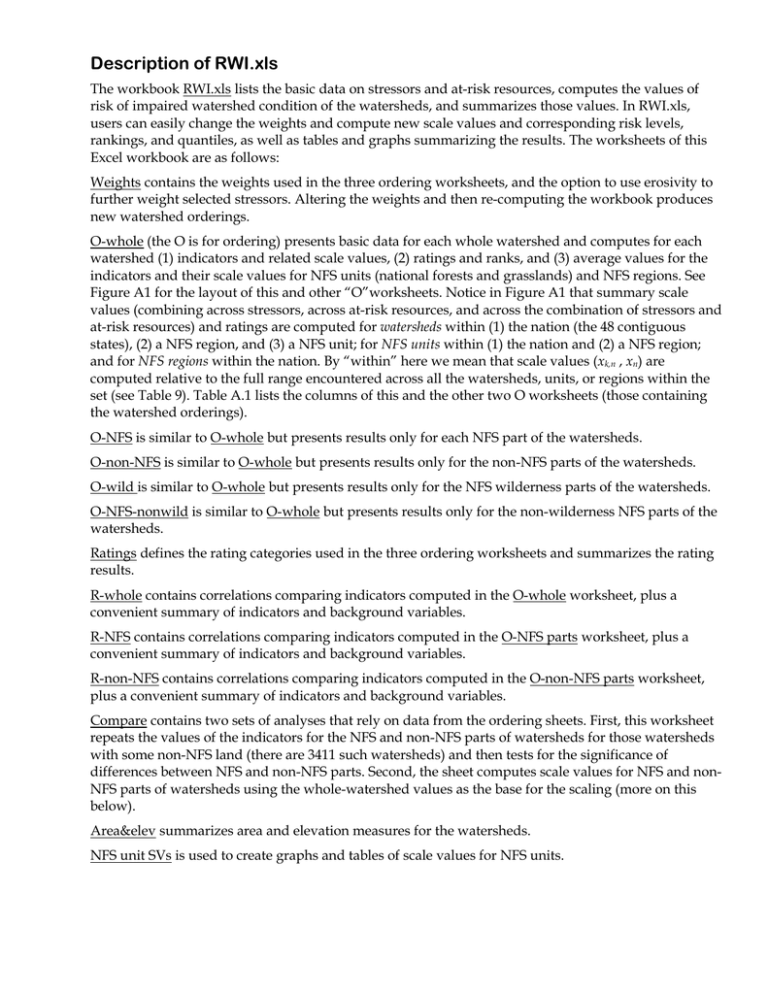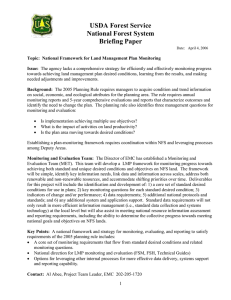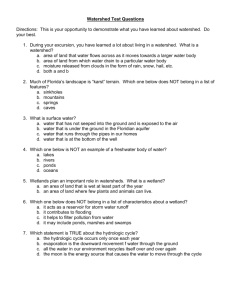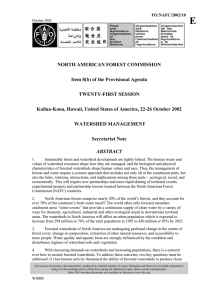Description of RWI.xls
advertisement

Description of RWI.xls The workbook RWI.xls lists the basic data on stressors and at-risk resources, computes the values of risk of impaired watershed condition of the watersheds, and summarizes those values. In RWI.xls, users can easily change the weights and compute new scale values and corresponding risk levels, rankings, and quantiles, as well as tables and graphs summarizing the results. The worksheets of this Excel workbook are as follows: Weights contains the weights used in the three ordering worksheets, and the option to use erosivity to further weight selected stressors. Altering the weights and then re-computing the workbook produces new watershed orderings. O-whole (the O is for ordering) presents basic data for each whole watershed and computes for each watershed (1) indicators and related scale values, (2) ratings and ranks, and (3) average values for the indicators and their scale values for NFS units (national forests and grasslands) and NFS regions. See Figure A1 for the layout of this and other “O”worksheets. Notice in Figure A1 that summary scale values (combining across stressors, across at-risk resources, and across the combination of stressors and at-risk resources) and ratings are computed for watersheds within (1) the nation (the 48 contiguous states), (2) a NFS region, and (3) a NFS unit; for NFS units within (1) the nation and (2) a NFS region; and for NFS regions within the nation. By “within” here we mean that scale values (xk,n , xn) are computed relative to the full range encountered across all the watersheds, units, or regions within the set (see Table 9). Table A.1 lists the columns of this and the other two O worksheets (those containing the watershed orderings). O-NFS is similar to O-whole but presents results only for each NFS part of the watersheds. O-non-NFS is similar to O-whole but presents results only for the non-NFS parts of the watersheds. O-wild is similar to O-whole but presents results only for the NFS wilderness parts of the watersheds. O-NFS-nonwild is similar to O-whole but presents results only for the non-wilderness NFS parts of the watersheds. Ratings defines the rating categories used in the three ordering worksheets and summarizes the rating results. R-whole contains correlations comparing indicators computed in the O-whole worksheet, plus a convenient summary of indicators and background variables. R-NFS contains correlations comparing indicators computed in the O-NFS parts worksheet, plus a convenient summary of indicators and background variables. R-non-NFS contains correlations comparing indicators computed in the O-non-NFS parts worksheet, plus a convenient summary of indicators and background variables. Compare contains two sets of analyses that rely on data from the ordering sheets. First, this worksheet repeats the values of the indicators for the NFS and non-NFS parts of watersheds for those watersheds with some non-NFS land (there are 3411 such watersheds) and then tests for the significance of differences between NFS and non-NFS parts. Second, the sheet computes scale values for NFS and nonNFS parts of watersheds using the whole-watershed values as the base for the scaling (more on this below). Area&elev summarizes area and elevation measures for the watersheds. NFS unit SVs is used to create graphs and tables of scale values for NFS units. Table A1. Columns of the ordering sheets of RWI.xls.a Column Variable Watershed and NFS codes A Watershed identifier (10-digit code) B Forest code or WRR code C NFS region number Basic data 2 D Total area (km ) E Total area without lakes (km ) F Minimum watershed/polygon elevation G Maximum watershed/polygon elevation H Mean watershed/polygon elevation I Population from year 2000 census tract data J Population from year 1990 county data K Population from year 2000 county data L Mean annual PPT (mm) M Land ownership: % NFS N Land ownership: % other federal O Land ownership: % private P Cover type: % forest (NLCD classes 41, 42, and 43) Q Cover type: % rangeland (NLCD classes 52 and 71) R Cover type: % water (NLCD classes 11 and 12) S Cover type: % wetland (NLCD classes 90 and 95) T Cover type: % agriculture (NLCD classes 81 and 82) U Cover type: % developed (NLCD classes 21, 22, 23 and 24) V Cover type: % quarries, mines, gravel pits (NLCD class 32) W Cover type: % barren land (NLCD class 31) X Cover type: % transitional (not used in the 2001 NLCD; all values 0) Y Stream length (m) Z Riparian buffer (m ) AA Slope > 3% (km ) AB Slope > 45% (km ) AC Erosive soils (m ) AD Area of high landslide incidence (m ) AE Housing density (units / 1000 hectares) AF Road density (mean distance to nearest road, m) AG Road-stream crossings (number) AH Riparian road length (m of road within 100m on either side of a stream) AI Steep roads (m of road on slopes > 45%) 2 2 2 2 2 2 Column Variable AJ Area in cultivation on slopes ≤ 3% (m ) AK Area in cultivation on slopes > 3%, (m ) AL Area in cultivation on erosive soils (soils meeting a k factor criterion (m ) AM Fire hazard (high risk of losing key ecosystem components, m ) AN Cattle (number) AO Horses (number) AP Sheep (number) AQ Mules (number) AR Bison (number) AS Alpacas (number) AT Llamas (number) AU Goats (number) AV Deer (number) AW Elk (number) AX Fed cattle (number) AY Hogs (number) AZ Chickens (number) BA Turkeys (number) BB Rabbits (number) BC Mink (number) BD Mines (number of active and inactive mines) BE Atmospheric deposition – SO4 (kg/ha/yr) BF Atmospheric deposition – NO3 (kg/ha/yr) BG Dams (number) BH Water bodies (m ) BI Drinking water intakes (number) BJ Wild and scenic rivers (m/km2 of watershed) BK Listed aquatic T&E species (number) BL Listed terrestrial T&E species (number) BM Rainfall-runoff erosivity factor (R) BN Km of water body failing to meet criteria for designated uses from 303(d) list. BO Km of steam failing to meet criteria for designated uses from 303(d) list 2 2 2 2 2 2 Stressors (v ) s n ,i 2 BP Population density (p/km ) BQ Annual population change (%) BR Developed land cover (%) BS Housing density (units / 1000 hectares) Column Variable 2 BT Road density (m / km ) BU Road-stream crossings (number / stream km) BV Roads in riparian areas (m / km ) BW Roads on steep slopes (m / km ) BX Cultivation-gentle slopes (% of land area) BY Cultivation-steep slopes (% of land area) BZ Agricultural land cover (%) CA Cultivation-erosive soils (% of land area) CB Livestock grazing density (animal units / km ) CC Confined animal feeding density (animal units / km ) CD Other land cover (quarries, mines, gravel pits) (% of land area) CE Mines (number / 100 km ) CF Fire condition class 3 (% of land area) CG Atmospheric deposition (SO4 + NO3 in kg/ha/yr) CH Dams / 100 km 2 2 2 2 2 At-risk resources 2 (v ) r n, j 2 CI Water bodies (m / km of watershed) CJ Drinking water intakes (number / 100 km ) CK Wild and scenic rivers (m / km of watershed) CL Listed aquatic T&E species (number) CM Listed terrestrial T&E species (number) 2 2 (x ) CN-DF Scale values of stressors DG-DK Scale values of at-risk resources s n ,i (x ) r n, j Summary for sedimentation (y ) s k ,n DL Sum of weighted scale values of stressors DM Sum of weighted scale values of at-risk resources DN Risk level of stressors Gk , n DO Risk level of at-risk resources Gk , n DP Sum of weighted scale values for watershed DQ Risk level Gk , n DR Ranks Rk , n ( ( ( ) s ) ( r ) ) DS-DY Repeat of previous 7 columns for nutrients DZ-EF Repeat of the 7 columns for toxics All three problems combined k ,n (y ) s n Sum of weighted scale values of stressors EH Sum of weighted scale values of at-risk resources EI Ratings of stressors Gn s r k ,n (y ) EG ( ) (y ) (y ) r n Column Variable EK ( ) Sum of values across problems ( y ) EL Risk level r Ratings of at-risk resources Gn EJ EM ( Gn ) . Ranks ( Rn ) EN Percentile rank EQ-FD n ( x ) and risk level ( G ) by problem for watersheds within regions, and then sum of values across problems ( y ) , resulting scale values ( x ) , and risk level ( G ) For watersheds within NFS units: sum of scale values ( x ) and risk level ( G ) by problem for watersheds within regions, and then sum of values across problems ( y ) , resulting scale values ( x ) , and risk level ( G ) For watersheds within regions: sum of scale values k ,n k ,n n n FE-FW n k ,n k ,n n n a n The non-NFS worksheet does not include columns EI-FA.






